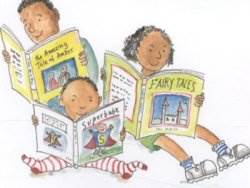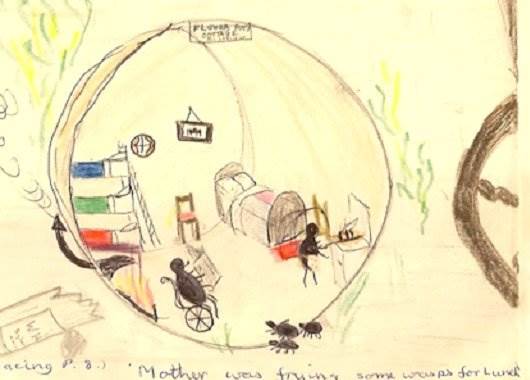Ros Asquith: Keeping difference in mind
Published on: 14 Tachwedd 2013
We caught up with illustrator Ros Asquith about dversity and inclusivity in picture books, ensuring your illustrations represent the world around you and her advice for new illustrators.

You are known for being an illustrator who recognises and celebrates diversity in all its forms. Can you tell us anything about how this started and how it has developed over the years?
It started when I was seven. I was shocked to hear that some landlords didn't rent rooms to Irish or black people (I'm much more shocked now, to hear that is still true in posh areas of London). Back then, I wrote a story about a caterpillar, Sebastian, who was looking for a home. Wherever he went, he found signs saying 'No Irish, Blacks, or Sebastian.' Later, I wrote about a spider whose dad was a wheelchair user: here's the picture I drew, aged nine:
As I recall it, Dad Spider is reading 'The Caterpillar Chronicle' and Mum spider is frying wasps (not much feminism evident yet).

Later, as a theatre critic and cartoonist, I saw that both professions and most drawings featured mainly white and mainly male characters. I wanted to redress this balance to include everyone equally. As a reviewer, I championed women's theatre and later touched on disability in my Teenage Worrier series (published by Random House).
I try to subvert stereotypes: for instance the teenage worrier Letty Chubb (who is white) is always banging on to her best friend Aggy (who is black) about racism. But Aggy is far more interested in particle physics.
Can you describe how you go about adding a disabled character – which comes first, the character or the disability?
The character or situation always comes first. I usually sketch out a scenario and then add colour, gender or disability in an almost random way -simply because I believe that anyone can be anything. If you think of race, gender or disability first, you are more likely to fall into stereotype.
What do you find to be the biggest challenges or pitfalls in trying to include disabled characters in your pictures?
The most obvious pitfall is in my mind. I have to consciously consider that a child or adult may have a disability and then include them in the general scheme of things. Since many disabilities are barely visible, this is not something that easily lends itself to general illustrations or especially cartoons where the gag is paramount. The second challenge is other people's expectations: does a character 'look' black enough? Might someone be 'offended' (such a wishy-washy notion) etcetera... This is all tricky territory , as the range of features, hairstyles, behaviours, desires in all races is enormous. I also resist making any 'minority' (women are of course a majority) especially kind or good. I think disabled children should be as naughty (or nice) as able bodied children.
Is there any one of your books that you are particularly proud of in terms of its inclusion of disability?
Max the Champion (written by Sean Stockdale and Alexandra Strick and illustrated by me) is a sweet book and the one most obviously featuring a wide range of abilities in both children and adults. Max is sports-mad and highly imaginative - it is only quite late on in the book that you might notice he wears a hearing aid and has asthma. It's a book you can read with kids without mentioning inclusivity, although Down's syndrome, cherubism, and many other differing abilities are featured. I am proud too of The Great Big Book of Families and The Great Big Book of Feelings, where I have tried to include as much diversity as possible.
Less obviously, my Letters from an Alien Schoolboy series deals with our perceptions of difference. The alien has to disguise himself as an Earthling and is surprised to discover that his best friend, Susan ('a very fine fellow'), is a girl. He considers himself spectacularly intellectually superior to human children, but discovers there are many different kinds of intelligence...
Do you ever need to do any research to make sure you get your images factually correct, and if so how easily (or otherwise) do you find sources of reference?
Yes, lots! I ask people for pictures, am always on the look out on the streets and use the internet, which is a fantastic resource.
What advice would you give to other illustrators in terms of developing a more inclusive approach?
Just to keep difference in mind. Think, for instance, if you're drawing a judge: does a judge have to be male, able bodied, white? Think too, if you have chosen to draw a child in a wheelchair, can they also be doing something else being active and participating fully, rather than being protected or on the sidelines? Does the parent rushing home to relieve the childminder have to be a mother? Can the family you are illustrating have two dads? Might older people be a tad athletic, or prefer Breaking Bad to knitting? And so on... It doesn't have to be obvious and it should never be 'worthy'. You could try imagining yourself as someone else and wondering what it would be like if someone like you never featured in a book or picture. Let your heroes be bad and make fools of themselves, but keep them different - and lively. Harry Potter did a lot for kids who wear glasses, something JK Rowling may not have been praised for enough.
Topics: Disability, Inclusive, Diversity (BAME), Features






Add a comment